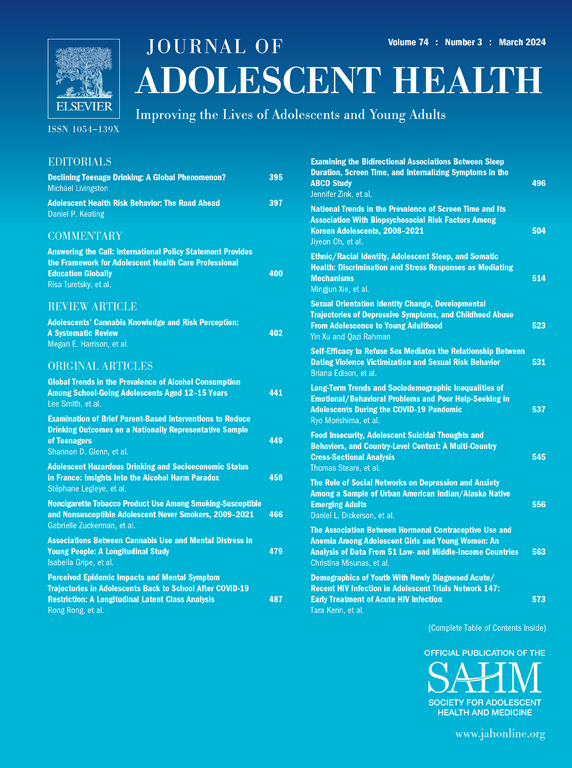入院前能量平衡对短期医疗结果的影响:再喂养以优化住院患者收益的研究结果
IF 5.5
2区 医学
Q1 PEDIATRICS
引用次数: 0
摘要
目的:热量限制和过度运动造成能量不平衡与医学后遗症的限制性饮食失调。我们研究了急性和慢性能量失衡对患有神经性厌食症(AN)和非典型AN的青少年和年轻人入院时疾病严重程度和再进食结果的影响。方法:二次数据分析来自再喂养以优化住院患者收益的研究,这是一项多中心随机试验,比较了120名因医疗不稳定住院的青年AN或非典型AN的高热量和低热量再喂养。每天测量生命体征。急性能量平衡的计算方法是入院前的热量输出(运动回忆加上估计的静息能量消耗)减去热量输入(饮食回忆)。慢性能量失衡变量包括入院前体重减轻的幅度、速率和持续时间。回归分析检验了能量平衡、疾病严重程度和再喂养结果之间的关系;优势度分析检验了能量平衡的相对重要性。结果:在82名参与者中(91%为女性),入院平均(SD)年龄为16.5(2.5)岁,%中位体重指数为85(10),急性能量平衡为-898(678)千卡。入院前急性能量平衡负的患者需要更多的天数(-0.18,[95% CI, -0.35, -0.02] p = .03)和千卡来恢复医疗稳定(-431.10,[95% CI, -857.06, -5.13] p = .047)。在决定这些结果时,急性能量平衡比体重抑制更重要。讨论:更严重的负能量平衡与更密集的再喂养需求相关,这支持纳入入院前饮食回忆和运动评估,以及体重史,以告知个性化的再喂养方案。本文章由计算机程序翻译,如有差异,请以英文原文为准。
The Effect of Preadmission Energy Balance on Short-Term Medical Outcomes: Findings From the Study of Refeeding to Optimize Inpatient Gains
Purpose
Caloric restriction and excessive exercise create an energy imbalance with medical sequelae in restrictive eating disorders. We examined the effect of acute and chronic energy imbalance on admission illness severity and refeeding outcomes in adolescents and young adults with anorexia nervosa (AN) and atypical AN.
Methods
Secondary data analysis from the Study of Refeeding to Optimize Inpatient Gains, a multicenter randomized trial comparing higher- versus lower-calorie refeeding in 120 youth with AN or atypical AN hospitalized with medical instability. Vital signs were measured daily. Acute energy balance was calculated as caloric output (exercise recall plus estimated resting energy expenditure) subtracted from caloric input (dietary recall) before admission. Chronic energy imbalance variables included magnitude, rate, and duration of weight loss before admission. Regression analyses examined associations among energy balance, illness severity, and refeeding outcomes; dominance analyses examined the relative importance of energy balance.
Results
Among 82 participants (91% female), admission mean (SD) age was 16.5 (2.5) years, %median body mass index was 85 (10) and acute energy balance was −898 (678) kilocalories. Those with more negative acute energy balance before admission required more days (−0.18, [95% CI, −0.35, −0.02] p = .03) and kilocalories to restore medical stability (−431.10, [95% CI, −857.06, −5.13] p = .047). Acute energy balance was a more important predictor than weight suppression in determining these outcomes.
Discussion
More acute negative energy balance was associated with a need for more intensive refeeding, which supports the inclusion of preadmission dietary recall and exercise assessments, alongside weight history, to inform individualized refeeding protocols.
求助全文
通过发布文献求助,成功后即可免费获取论文全文。
去求助
来源期刊

Journal of Adolescent Health
医学-公共卫生、环境卫生与职业卫生
CiteScore
10.40
自引率
3.90%
发文量
526
审稿时长
46 days
期刊介绍:
The Journal of Adolescent Health is a scientific publication dedicated to enhancing the health and well-being of adolescents and young adults. Our Journal covers a broad range of research topics, spanning from the basic biological and behavioral sciences to public health and policy. We welcome a variety of contributions, including original research papers, concise reports, literature reviews, clinical case reports, opinion pieces, and letters to the editor. We encourage professionals from diverse disciplines such as Anthropology, Education, Ethics, Global Health, Health Services Research, Law, Medicine, Mental and Behavioral Health, Nursing, Nutrition, Psychology, Public Health and Policy, Social Work, Sociology, and Youth Development to share their expertise and contribute to our mission of promoting adolescent health. Moreover, we value the voices of young individuals, family and community members, and healthcare professionals, and encourage them to submit poetry, personal narratives, images, and other creative works that provide unique insights into the experiences of adolescents and young adults. By combining scientific peer-reviewed research with creative expressions, our Journal aims to create a comprehensive understanding of the challenges and opportunities in adolescent and young adult health.
 求助内容:
求助内容: 应助结果提醒方式:
应助结果提醒方式:


